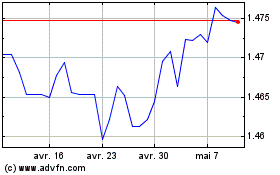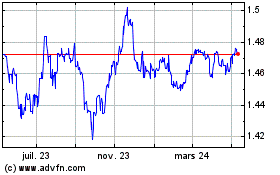Euro Slides Amid Risk Aversion, French Political Uncertainty
10 Juin 2024 - 6:30AM
RTTF2
The euro weakened against other major currencies in the European
session on Monday amid risk aversion, in the wake of political
upheaval in France following President Emmanuel Macron's demand for
an early legislative election.
French President Emmanuel Macron called a shock election after
being trounced in the European Union vote by the far-right
parties.
Italian Prime Minister Giorgia Meloni's far-right party has won
European elections in Italy with a strong 28 percent of the
votes.
Markets in China, Hong Kong and Australia are closed for public
holidays.
In the European trading now, the euro fell to nearly a 2-year
low of 0.8453 against the pound and nearly a 2-month low of 0.9642
against the Swiss franc, from early highs of 0.8472 and 0.9668,
respectively. The euro is likely to find support around 0.82
against the pound and 0.93 against the franc.
Against the yen and the U.S. dollar, the euro slipped to a 5-day
low of 168.71 and a 1-month low of 1.0748 from early highs of
169.22 and 1.0782, respectively. The next possible downside target
for the euro is seen around 164.00 against the yen and 1.05 against
the greenback.
Against the Australia and the Canadian dollars, the euro dropped
to a 4-day low of 1.6301 and a 1-week low of 1.4790 from early
highs of 1.6388 and 1.4838, respectively. If the euro extends its
downtrend, it is likely to find support around , 1.61 against the
aussie and 1.46 against the loonie.
The euro edged down to 1.7591 against the NZ dollar, from an
early high of 1.7670. On the downside, 1.74 is seen as the next
support level for the euro.
Meanwhile, the safe-haven currency or the U.S. dollar,
strengthened against its major rivals amid risk aversion.
The stronger-than-expected jobs data for May also boosted the
dollar and reduced hopes of an interest rate cut by the Federal
Reserve in September.
Data from the Labor Department showed on Friday that non-farm
payroll employment surged by 272,000 jobs in May after climbing by
a downwardly revised 165,000 jobs in April.
Economists had expected employment to increase by about 185,000
jobs compared to the addition of 175,000 jobs originally reported
for the previous month.
Against the pound, the Swiss franc and the yen, the U.S. dollar
advanced to 1-week highs of 1.2707, 0.8983 and 157.20 from early
lows of 1.2731, 0.8957 and 156.72, respectively. If the greenback
extends its uptrend, it is likely to find resistance around 1.24
against the pound, 0.93 against the franc and 160.00 against the
yen.
Against Australia, the New Zealand and the Canadian dollars, the
greenback advanced to a 1-month high of 0.6576, nearly a 2-week
high of 0.6099 and nearly a 1-1/2-month high of 1.3774 from early
lows of 0.6596, 0.6112 and 1.3756, respectively. The greenback may
test resistance near 0.63 against the aussie, 0.58 against the kiwi
and 1.39 against the loonie.
Looking ahead, U.S. CB employment trends index for May is slated
for release in the New York session.
Euro vs CAD (FX:EURCAD)
Graphique Historique de la Devise
De Mai 2024 à Juin 2024

Euro vs CAD (FX:EURCAD)
Graphique Historique de la Devise
De Juin 2023 à Juin 2024
